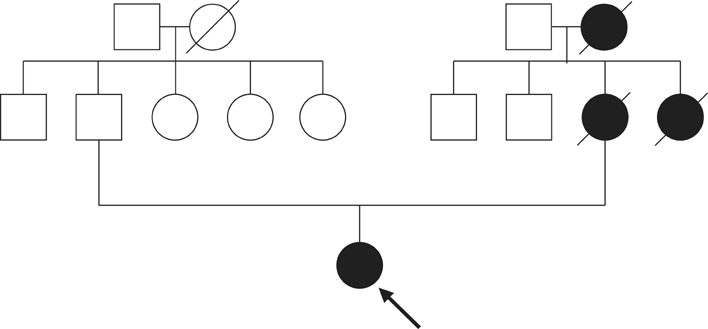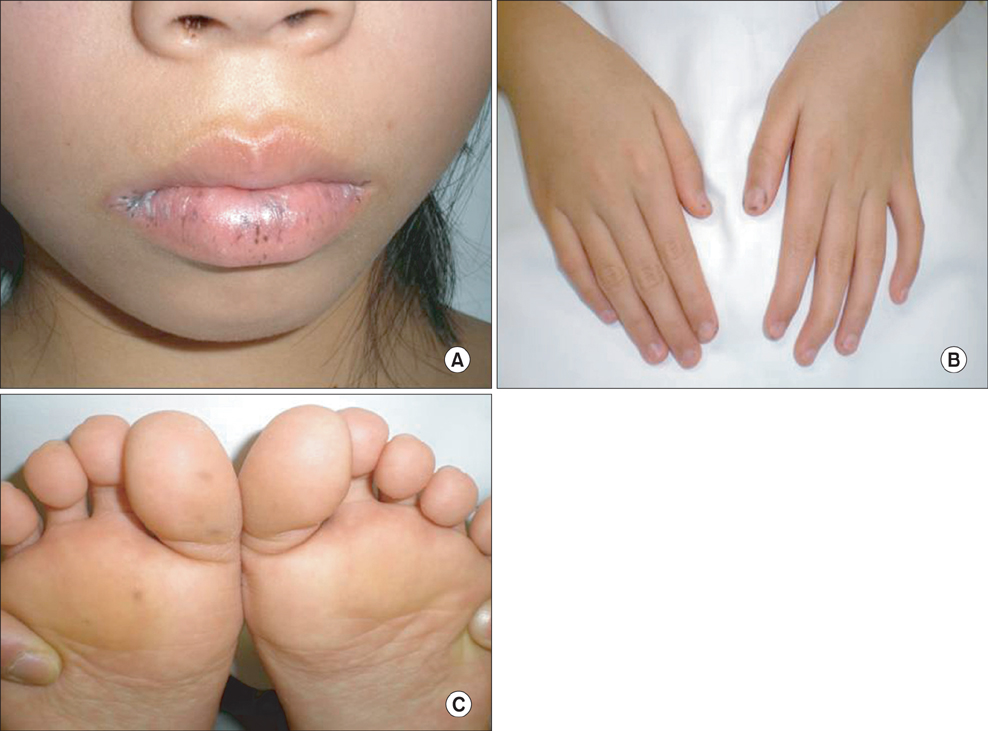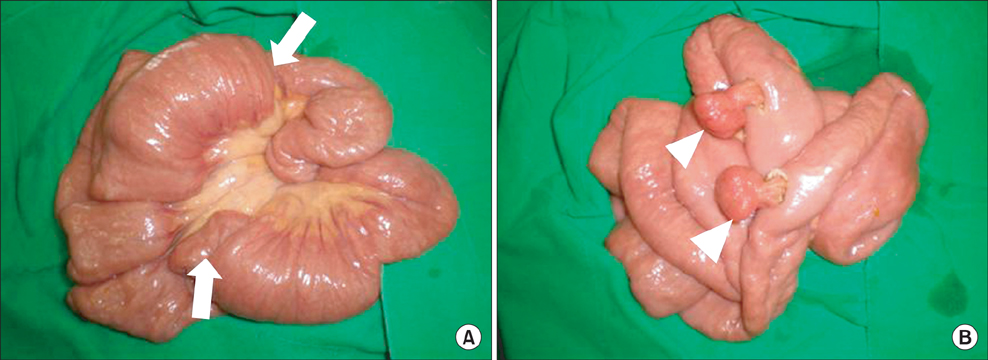Ann Surg Treat Res.
2014 Jun;86(6):325-330. 10.4174/astr.2014.86.6.325.
Peutz-Jeghers syndrome with germline mutation of STK11
- Affiliations
-
- 1Department of Surgery, Catholic University of Daegu School of Medicine, Daegu, Korea. hdchae@cu.ac.kr
- 2Department of Laboratory Medicine, Catholic University of Daegu School of Medicine, Daegu, Korea.
- KMID: 2167111
- DOI: http://doi.org/10.4174/astr.2014.86.6.325
Abstract
- Peutz-Jeghers syndrome (PJS), also known as periorificial lentiginosis, is a rare autosomal dominant inherited disease with an incidence of 1/200,000 live-borns. Mutations in the serine-threonine kinase 11 (STK11) gene are considered the major cause of PJS. The most frequent complication at young age is recurrent intussusception due to multiple hamartomatous polyps, primarily in the small intestine. Although extremely rare, the small bowel should be fully examined to be certain additional intussusceptions are not present. Herein, we report on a case of PJS with germline mutation of STK11 in a 12-year-old young girl who presented as a rare case of two small intestinal intussusceptions and review the literature.
Keyword
MeSH Terms
Figure
Cited by 1 articles
-
Peutz-Jeghers Syndrome with Adenomatous Change in a Fifteen-month-old Boy
Kun Song Lee, Seung Ho Lee, Na-Hye Myong
Korean J Gastroenterol. 2015;66(2):106-110. doi: 10.4166/kjg.2015.66.2.106.
Reference
-
1. Giardiello FM, Trimbath JD. Peutz-Jeghers syndrome and management recommendations. Clin Gastroenterol Hepatol. 2006; 4:408–415.2. Jenne DE, Reimann H, Nezu J, Friedel W, Loff S, Jeschke R, et al. Peutz-Jeghers syndrome is caused by mutations in a novel serine threonine kinase. Nat Genet. 1998; 18:38–43.3. Hemminki A, Markie D, Tomlinson I, Avizienyte E, Roth S, Loukola A, et al. A serine/threonine kinase gene defective in Peutz-Jeghers syndrome. Nature. 1998; 391:184–187.4. Dong K, Li B. Peutz-Jeghers syndrome: case reports and update on diagnosis and treatment. Chin J Dig Dis. 2004; 5:160–164.5. Riegert-Johnson D, Roberts M, Gleeson FC, Krishna M, Boardman L. Case studies in the diagnosis and management of Peutz-Jeghers syndrome. Fam Cancer. 2011; 10:463–468.6. Hearle N, Schumacher V, Menko FH, Olschwang S, Boardman LA, Gille JJ, et al. Frequency and spectrum of cancers in the Peutz-Jeghers syndrome. Clin Cancer Res. 2006; 12:3209–3215.7. Amos CI, Keitheri-Cheteri MB, Sabripour M, Wei C, McGarrity TJ, Seldin MF, et al. Genotype-phenotype correlations in Peutz-Jeghers syndrome. J Med Genet. 2004; 41:327–333.8. Lim W, Olschwang S, Keller JJ, Westerman AM, Menko FH, Boardman LA, et al. Relative frequency and morphology of cancers in STK11 mutation carriers. Gastroenterology. 2004; 126:1788–1794.9. Oncel M, Remzi FH, Church JM, Connor JT, Fazio VW. Benefits of 'clean sweep' in Peutz-Jeghers patients. Colorectal Dis. 2004; 6:332–335.
- Full Text Links
- Actions
-
Cited
- CITED
-
- Close
- Share
- Similar articles
-
- Peutz-Jeghers syndrome: a new understanding
- Solitary Peutz-Jeghers type harmartomatous polyp in duodenum with gastric foveolar epithelium: a case report
- Minimal deviation adenocarcinoma of the cervix and tumorlets of sex-cord stromal tumor with annular tubules of the ovary in Peutz-Jeghers syndrome
- A Pyloric Gland-Phenotype Ovarian Mucinous Tumor Resembling Lobular Endocervical Glandular Hyperplasia in a Patient with Peutz-Jeghers Syndrome
- Peutz-Jeghers Syndrome with Recurrent Intussusception





